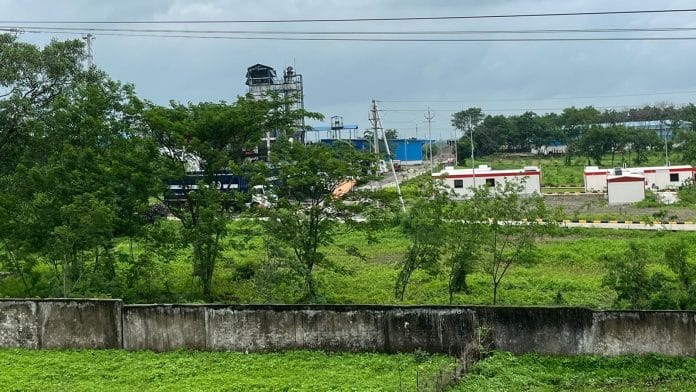Pithampur (Madhya Pradesh): Behind a pale blue shutter, sealed with rusted locks, sits a mixture of sevin, pesticide, and contaminated soil—industrial trash that has remained untouched for nearly forty years. The Union Carbide India Limited factory was handed a similar fate, but while the compound continues to decay, this 337 metric tonnes of waste is being liberated—or more appropriately—incinerated.
From the US to the UAE, countries around the globe employ Hyderabad-based Re Sustainability Ltd to burn their trash. Now, Bhopal is headed their way too.
Colloquially, it is called “Bhopal ka kachda”. Its fate has been the subject of heated discussions in street protests, court battles, and corporate boardrooms for over two decades. Beyond compensation struggles, the toxic waste embodies a more fundamental fight at the heart of the 1984 Bhopal gas tragedy: environmental remediation. But it is not just about how the waste is disposed of; survivor communities also assert the polluter-pays principle and do not want the government to shell out taxpayers’ money on disposal.
And yet, the residents of Tarpura village in Pithampur face the same dreaded outcome— toxic Bhopal waste is due to wind up in their neighbourhood, and taxpayer money is funding its disposal. In March 2024, the Centre transferred Rs 126 crore to the Madhya Pradesh government, giving the much-maligned incinerator a green light. This facility, built in 2005, has the capacity to incinerate 20,000 MT, much more than the 337 MT of waste coming from Bhopal. The process involves collection, packing, unloading, and storage. Once the waste has been analysed, the incineration ‘recipe’ will be confirmed, setting stage for D-day—either the 72nd or 197th day when the incinerator begins to ‘neutralise’ the trauma-laden, politically fraught, and monumentally feared waste.
Our village was here first. We’ve been here far longer than the factory has. Of course we’re going to protest. People inside the factory will be safe, but what about our safety?
Babu, a shopkeeper in Tarpura
Still, this is waste that no one wants. When the Supreme Court proposed alternative disposal sites in Gujarat and Andhra Pradesh, local pollution control boards rejected them citing pressure from environmental groups. “People have expressed apprehensions, including about the toxicity of the waste material,” reads a 2007 letter from the Gujarat PCB. Even the German government agency GIZ withdrew from the plan at the last minute in 2013, with chartered airplanes ready to transport the waste.
Now, the toxic waste is causing a storm for the second time. Whether it’s Bhopal, Indore, or Pithampur, anger among local people and politicians is palpable.
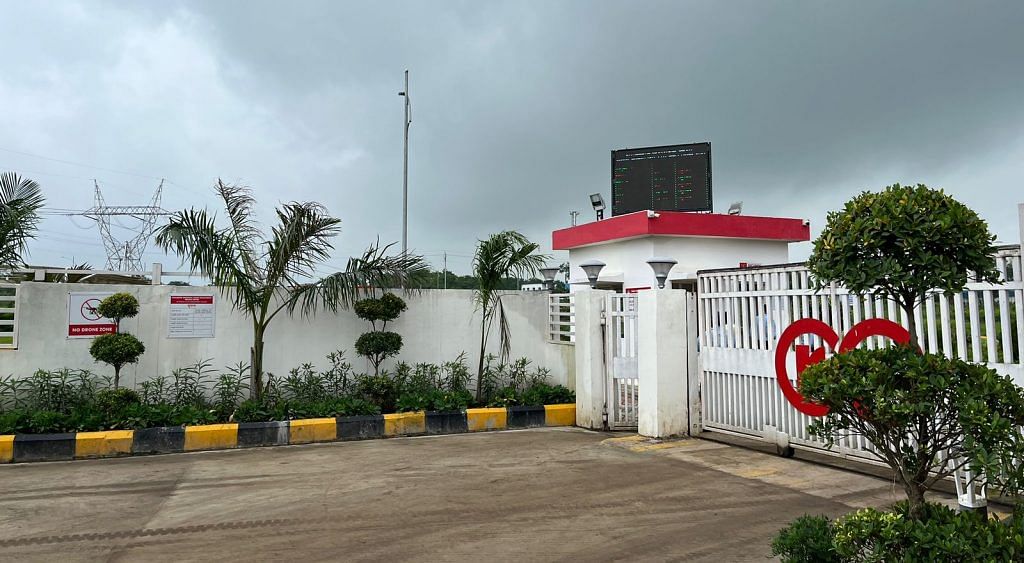
“Our village was here first. We’ve been here far longer than the factory has,” said Babu, a shopkeeper in Tarpura, whose view of lush green fields from the roof of his house is obstructed by the listless grey incinerator at the waste plant barely 500 metres away—enough to meet the Central Pollution Control Board (CPCB) guidelines for hazardous waste.
“Of course we’re going to protest. People inside the factory will be safe, but what about our safety?”
Also read: The lazy way to remember the Bhopal Gas tragedy
‘Not the same company anymore’
Tarpura’s fate became linked to the Bhopal waste with the arrival of RE Sustainability—then Ramky Enviro Engineers Ltd—in 2005. This facility is responsible for disposing of all industrial waste in Madhya Pradesh.
For Re Sustainability, which operates in 17 countries and aims to expand its fleet of industrial waste plants in India from 21 to 26 by the end of the year, neutralising what represents four decades of trauma is both a matter of “pride and responsibility”.
Between 2010 and 2015, the facility conducted seven incineration trials, the final one involving 10 tonnes of waste from the abandoned and rusting factory in Bhopal. This trial was deemed successful, with pollution levels remaining within prescribed limits.
However, until that final trial, the company didn’t have a multi-effect evaporator, vital for reducing emissions. Now it does.
If even a single person is hospitalised, we will start protesting. Lakhs of people are with us.
Gautam Kothari, president, Pithampur Audhyogik Sangathan
The company claims to have tinkered with the incineration ‘recipe’ and is confident that there are no risks involved. Everything will be monitored in real time, leaving nothing to chance. The Tarpura plant is equipped with a state-of-the-art cleaning system and a multi-treatment scrubbing facility, a globally accepted technique for eliminating emissions. The incinerator itself is designed to prevent emissions, and there is a vast sprinkler system in case the waste catches fire. Even if that fails, there are “other lines of defense.”
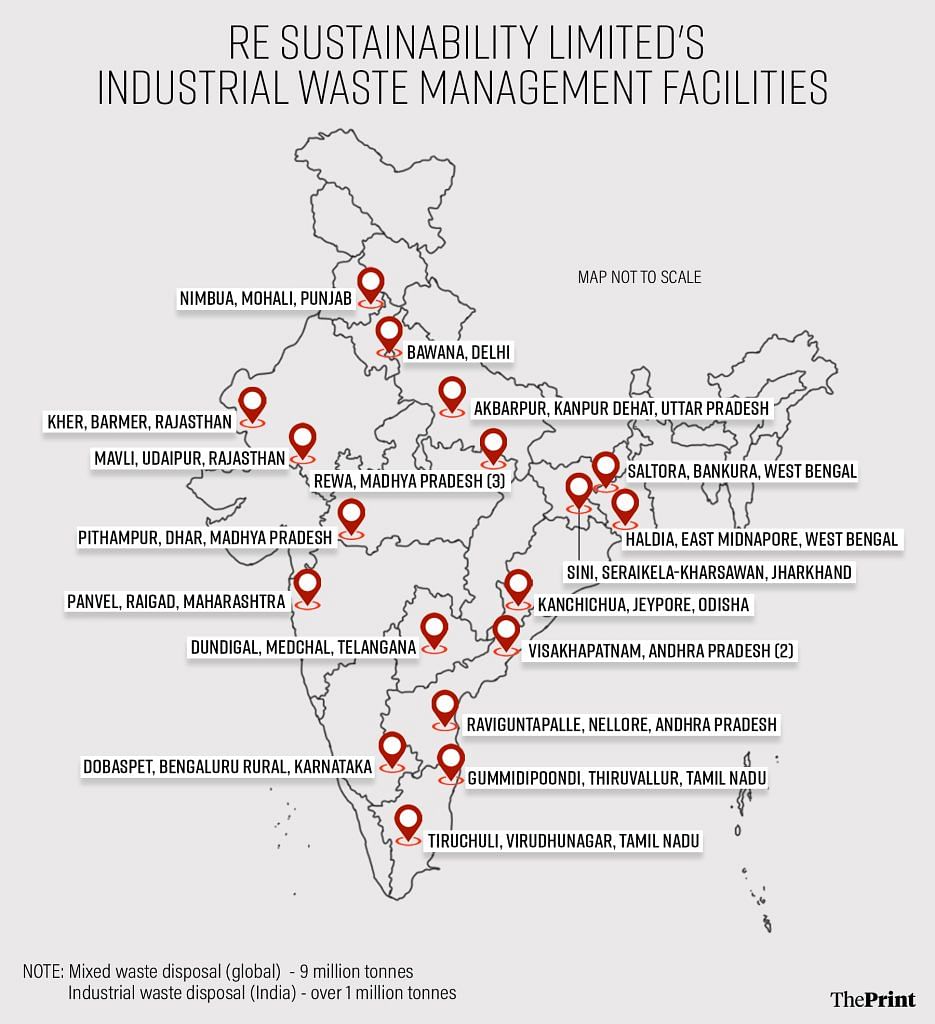
Yet, a 2022 report by the CPCB found that residents had already been exposed to “high-levels” of dioxins and furans—by-products of industrial activities. According to the World Health Organization (WHO), short-term exposure may cause skin lesions, while prolonged exposure can impair the nervous, endocrine, and reproductive systems, and has been linked to cancer in animals.
The chief industry body, which led the protests in 2010, is wary of the disposal process.
“The kiln capacity is 2,500 kg per hour. But the waste was burnt at only 90 kg per hour [during the 2015 trial]. The capacity was low, and so nothing was released into the air,” said Gautam Kothari, president of the Pithampur Audhyogik Sangathan, the town’s primary industry body. Kothari’s desk in his Indore office is piled with documents—court orders, pollution reports, and papers confirming the arrival of RE Sustainability. It’s all ammunition for the battle that is about to be waged.
If I throw trash in my neighbour’s home, shouldn’t I be responsible for cleaning it up?
“All safety measures are in place. When we initiated the tender, we addressed all forms of pollution with the authorities. All rules have been followed,” said Vishvas Sarang, BJP leader and former minister for Gas Tragedy Relief and Rehabilitation until January 2024. “How can anyone question me? My entire family is gas-affected.” Sarang is one of lakhs of people in Bhopal for whom the memory of the leak is as concrete and undiminished by time as the factory itself.
“If even a single person is hospitalised, we will start protesting,” Kothari warned. “Lakhs of people are with us.”
It could be a repeat of July 2010. Following widespread, dramatic protests, then-Union Environment Minister Jairam Ramesh visited the site and declared that no final decision on disposal would be made without consulting the residents of Tarpura and neighbouring villages. Two years earlier, in 2008, villagers had alleged that waste from the Bhopal factory had been secretly transported and dumped at the plant, contaminating their groundwater.
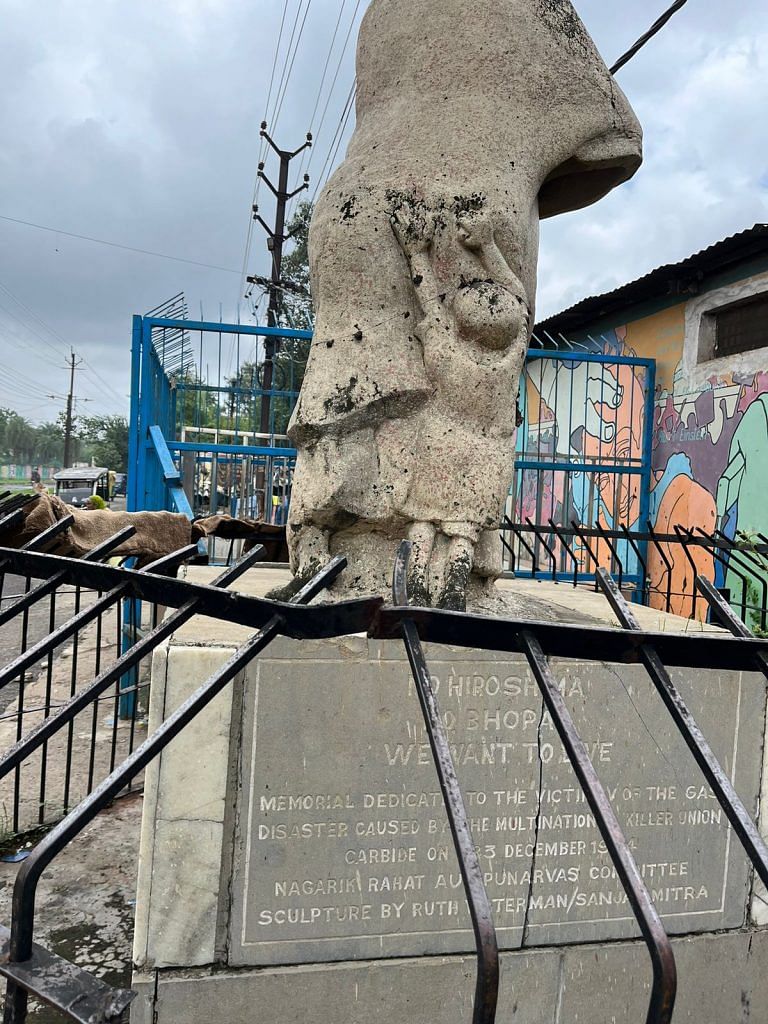
Also read: Why the Centre should not pay Bhopal gas tragedy victims from its kitty
Polluter pays—Dow Chemical won’t
A road separates JP Nagar from the Union Carbide factory in Bhopal. From the street, a portion of the manufacturing unit is visible, its dense, burnt-brown rooftop blending into the skyline.
For local residents, the lingering presence of toxic waste from the Union Carbide factory is a stark reminder of their past suffering. They are certain that the waste should not be relocated.
“If I throw trash in my neighbour’s home, shouldn’t I be responsible for cleaning it up?” asks a survivor, who was four years old at the time, in a folksy articulation of the polluter-pays principle. Jameela Bi echoes this sentiment, asserting, “Nothing from here should go anywhere.”
“The responsibility lies with that American company. The people of Bhopal died,” Bi says bitterly, her skin pale and gums bloodied. “Do they want to kill more?”
Studies have reported increased health issues among residents, ranging from skin lesions to cancer. The Madhya Pradesh High Court’s 2008 order emphasised the need for further research into the health impacts on victims. A report by the Central Ground Water Authority, presented to the National Green Tribunal in March this year, confirmed the presence of heavy metals in groundwater around the factory.
Nothing from here should go anywhere. The responsibility lies with that American company. The people of Bhopal died. Do they want to kill more?
Jameela Bi, a resident of Bhopal
Dow Chemical, which acquired Union Carbide 16 years after the tragedy—and “12 years after the $470 million settlement”—told ThePrint in a written response that they are not responsible for the waste. “[It’s] important to recognise that TDCC never owned or operated the plant; it was owned and operated by Union Carbide India Limited.”
While the potential danger and associated fears are widespread, the people of Pithampur, who haven’t lived under the shadow of disaster for forty years, see this not as a matter of principle but as a fight to prevent their town from becoming another Bhopal.
“Chemicals from the Bhopal disaster are coming to us. There will be pollution,” says a young Tarpura resident, his tone flat. He may not fully understand the events of 1984 or the operation of the incinerator, but he is confident of its ill-effects.
Others, however, remain hopeful. Sandeep Raghuvanshi, originally from Tarpura, holds a placard featuring the iconic photograph of a dead-child under rubble, clicked by Pablo Bartholomew. “I will not let Pithampur become Bhopal. I will not let waste from the gas tragedy be burnt in Pithampur,” it reads.
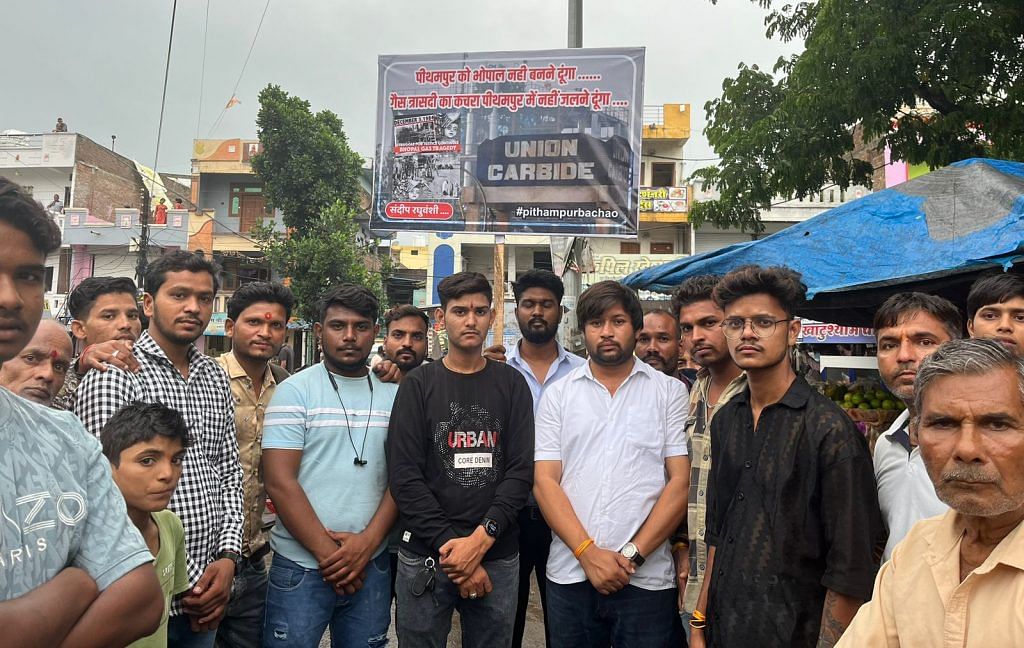
Raghuvanshi and others have been protesting at key locations in Pithampur, including the newly renovated Maharana Pratap Bus stop and the nagar palika in Tarpura.
“We will keep protesting. I will go to Bhopal and stand outside Vallabh Bhawan. If they don’t stop, I will go to Delhi,” says Raghuvanshi, surrounded by about 20 supporters. “Why can’t this happen where there are no people? Or why can’t the waste be thrown in the sea?” he asks. The group is also critical of local politicians, including BJP MLA Neena Verma, who have expressed reservations about the waste disposal plan but have not actively joined the protests.
We will keep protesting. I will go to Bhopal and stand outside Vallabh Bhawan. If they don’t stop, I will go to Delhi. Why can’t this happen where there are no people? Or why can’t the waste be thrown in the sea?
Sandeep Raghuvanshi
At a meeting in Delhi’s Paryavaran Bhawan in 2010, then-Madhya Pradesh environment and housing minister Jayant Maliya expressed a major concern: the incinerator falls within the catchment area of the Yashwant Sagar Dam, a major water source for Indore. When contacted by ThePrint, Malaiya said that he no longer holds any views on the subject.
Also read: Abdul Jabbar, Bhopal gas tragedy’s oldest activist, turned ailing survivors into warriors
Contaminated soil, polluted water
The incineration proposal entered public discourse in 2008, but the suffering began decades earlier. “Everything needs to be cleaned up. Local politics keeps this issue burning,” said Nivit Yadav, programme director of Industrial Pollution at Centre for Science and Environment (CSE), a Delhi-based think tank. “The longer the waste stays, the more contamination there will be.”
Residents have been exposed to a toxic mix of heavy metals like mercury and chromium, volatile organics like chloroform and methylene chloride, and pesticides through their soil and water. The effects range from mild symptoms like shortness of breath to life-threatening cardiovascular problems and kidney disease.
Inside the Union Carbide factory, creepers have overrun old pipelines, wildflowers threaten machinery, and wild pigs roam workers’ quarters. Though entry is prohibited, people find ways inside through broken walls.
All this waste at the Union Carbide factory was once ready for transportation to Germany. The Union cabinet had approved funds for airlifting the waste, the German government had granted permission, and a budget of Rs 56 crore was set. But public outcry in Germany forced the company GIZ to pull out at the last minute.
Nearby, 400 metres north, Solar Evaporation Ponds (SEPs) built by Union Carbide—another immersion point for effluents—now host buffaloes. This encroachment by nature is a reminder that four decades have passed and the damage has already been done.
A 1997 report by the National Environmental Engineering Research Institute (NEERI) noted 21 unlined pits where toxic waste was routinely dumped, contaminating the soil and groundwater. A peer review committee report submitted to the Department of Science and Technology estimated 1.1 million tonnes of contaminated soil.
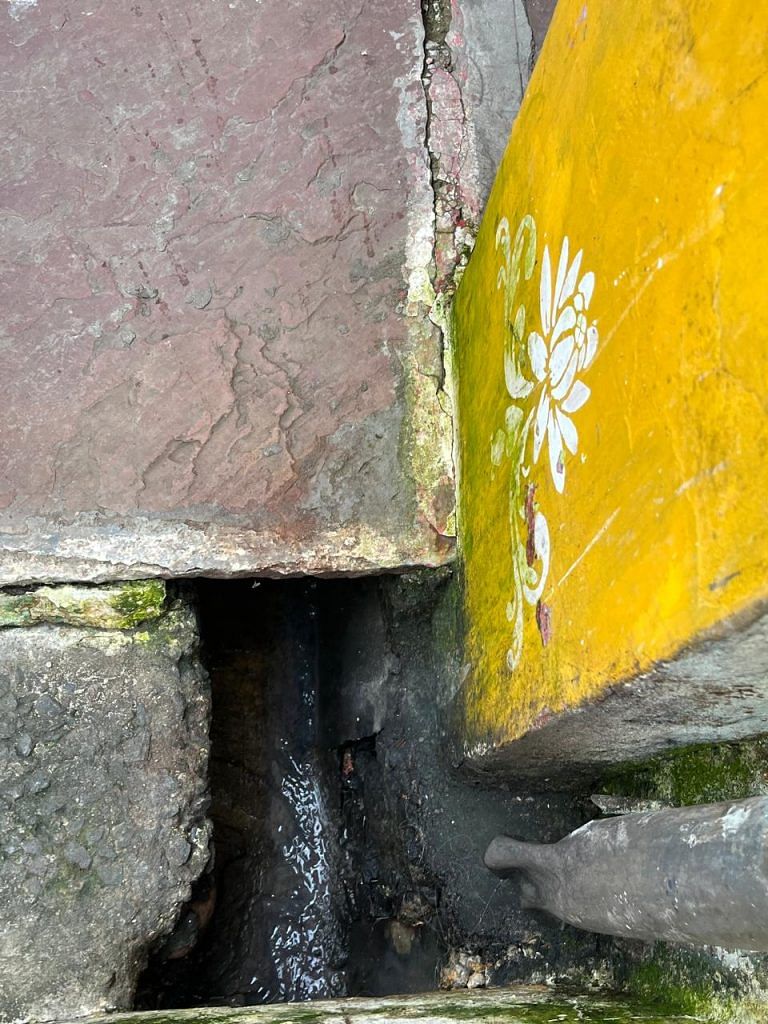
Residents remember the UCIL effluents flowing into an open drain, which turned the water from yellowish to red. Shehraz Khan, who moved in after 1984, suffers from frequent headaches and low blood pressure. “The water from the hand-pump was red,” he said.
Health problems in the area include thyroid issues, diabetes, high blood pressure, and kidney failure. Today, the open drain in JP Nagar is now greasy and stagnant, but residents now receive water from the Narmada River, made possible by years of protest and activism from survivors.
“We’ve fixed the water problem and connected the pipes to the Narmada River,” said Sarang. “We’ve done soil testing. Look at how green it all is.”
There are glaring contrasts. Idnis Khan was 15 when the gas leaked. In the years since, he lost his mother to kidney failure, father to cancer, and brother during the Covid-19 pandemic. His younger sister could never walk. Two of his four children have cognitive disabilities and are unemployed.
“I have always had breathing difficulties, now I also have digestive issues,” he says, standing by the railway tracks in Ayub Nagar. He rolls up his pant to show a swollen bulge on his calf. “Whoever has died has died. But what about those who are alive?” he asks.
At the Sambhavna Clinic, a local NGO for gas victims that receives over a hundred patients every day, over 37,000 people have been treated.
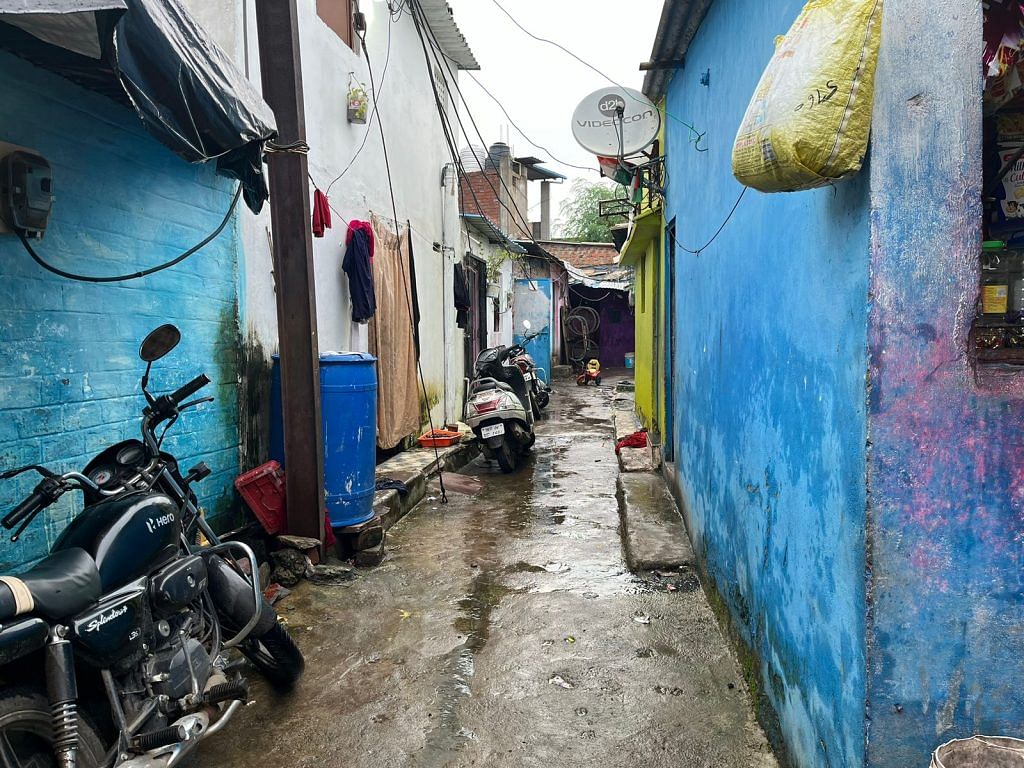
“We’re not just gas victims; we’re water victims. My children drank that water for decades,” says Firoza Bi, a resident of Blue Moon Colony who lost her 22-year-old son to kidney failure ten days ago. “My breath swells, my eyes burn, and I’m always falling sick. My skin used to be covered in spots.”
In Pithampur, villagers referred to the Narmada as a “saviour.” Until it turned murky. They attribute the strange taste of water, itchy skin, and blisters that once covered their mouths to “Ramky”—Re Sustainability Ltd.
We’re not just gas victims; we’re water victims. My children drank that water for decades
Firoza Bi
“Our water is full of acids and chemicals. Does anyone check where the waste is coming from?” said Gansham, a Cheerakhan village resident in his 70s. The prospect of Union Carbide factory waste ending up in his neighbouring Tarpura compounds his anxiety. “Protests don’t work. This time I’m not going to partake. Why should I get beaten up by the police?”
While villagers complain about local factories dumping effluents into tube wells, their grouse against Re Sustainability has another angle to it: the company hasn’t provided local employment. The well from which Tarpura residents used to collect water is right next to the complex.
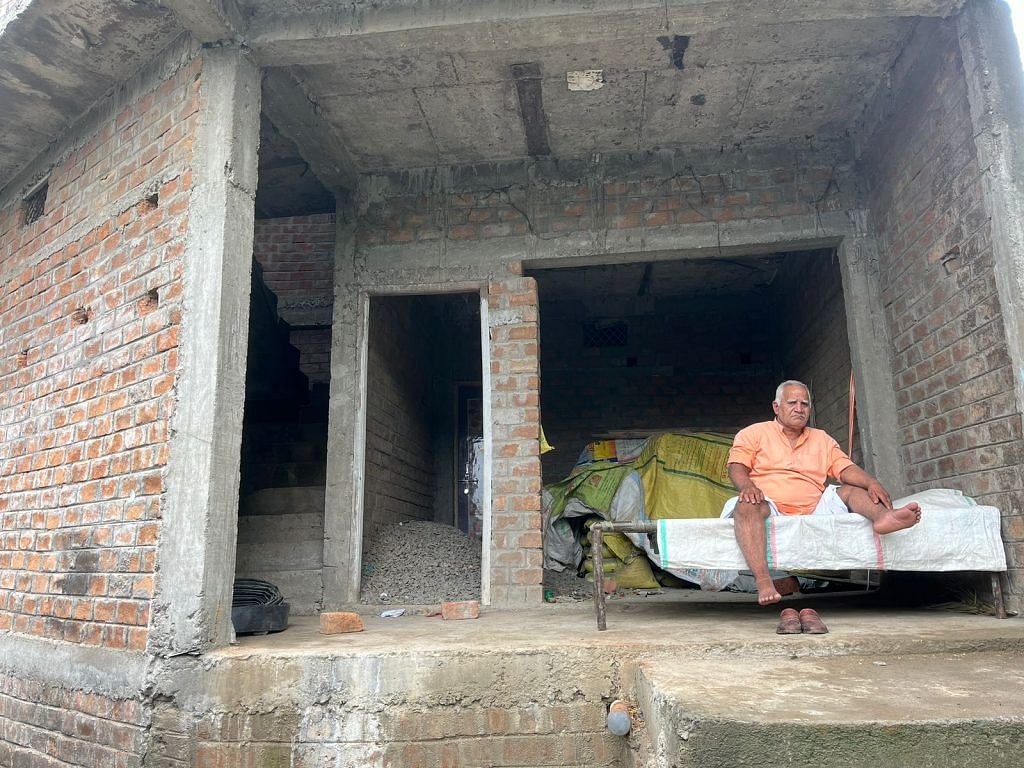
Also read: These documents show how India and Union Carbide colluded on the Bhopal Gas tragedy
Alternative solutions
A Madhya Pradesh Pollution Control Board expert, who did not want to be named, said that after lying dormant for four decades, the waste has likely lost much of its hazardous properties. Another expert noted that the waste is considered semi-stable, which means it will not be stabilised using lime or placed in a polymer matrix, as this would create additional waste.
However, minutes from an Oversight Committee Meeting in 2023 accessed by ThePrint indicated that lime would be used, potentially tripling the volume from 300+ MT to 900 MT.
All this waste at the Union Carbide factory was once ready for transportation to Germany. The Union cabinet had approved funds for airlifting the waste, the German government had granted permission, and a budget of Rs 56 crore was set. Transpiration was due to commence in early 2013.
“The Indian Government is confident that GIZ will safely dispose of the soil, which has not been adequately protected and has been in storage for almost 28 years,” the company’s then-regional director Hans Hermann-Dube had said.
But GIZ, which had completed 25 similar projects until then, backed out.
Public outcry in Germany following an information leak led Hermann-Dube to shift his stance, saying it would be in “interest of strong Indo-German cooperation not to pursue the project further.”
GIZ’s letter also highlighted India’s inadequate facilities for incineration, a process involving high heat to break chemical bonds and reduce toxicity.
Professor Shyamala Mani, currently working as Senior Advisor—Waste Management at the Centre for Chronic Disease Control (CCDC), explained that high heat generates acidic gases that require neutralising compounds, resulting in substantial waste. Mani’s experiments with similar materials suggested that different fungal species including yeast could be used to transform pesticides into safer by-products. She also recommended using pressmud, a by-product from sugarcane, for microbial degradation instead of incineration to ensure safe burial in a landfill, though this would require further lab analysis. There are certain bonds in sevin that are difficult to break, she said.
Using soil microorganisms and the contents of easily found agricultural waste like pressmud has always been recommended by scientists.
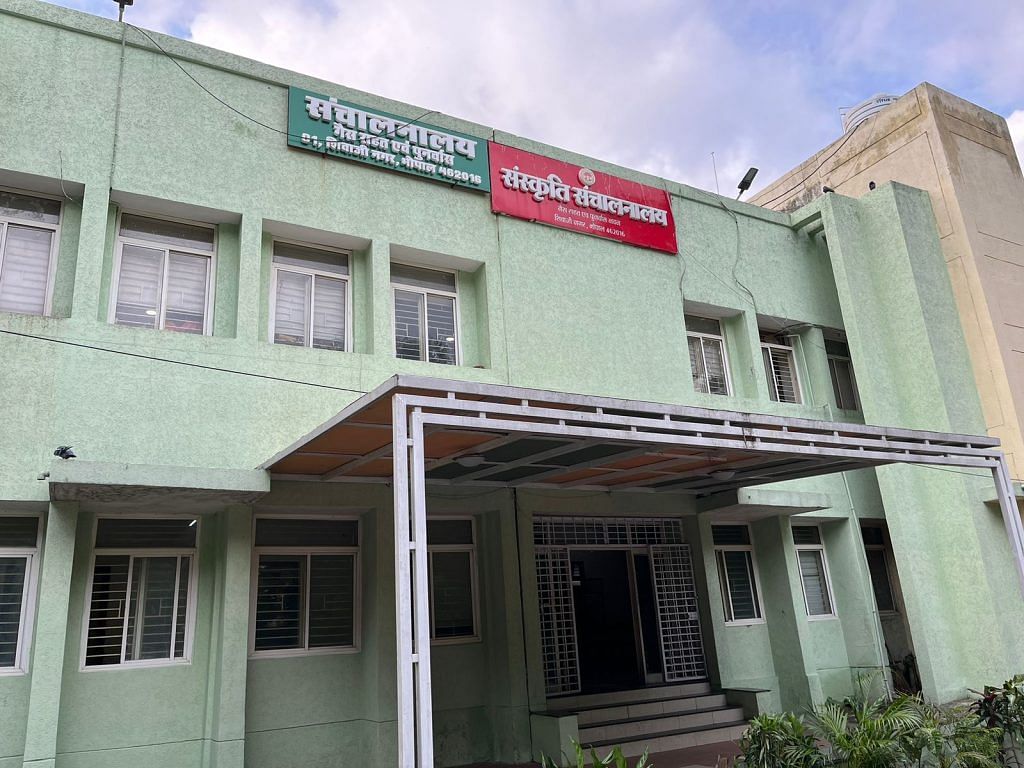
An anonymous Bhopal-based industrial engineer suggested that chemical methods on-site could render the waste inert.
“Microbial degradation can be tried and the by-products can be put in a secured landfill. That way, we don’t need to endanger the lives of humans and livestock,” the engineer-turned-businessperson said.
Yadav argued that the Pithampur facility is already incinerating highly hazardous waste. “This is a problem that can be solved,” he said. Currently, all residue is buried on RE Sustainability’s grounds.
Regardless of how much waste is disposed of and when, problems will persist for the people of Tarpura—and ‘Ramky’ will forever be in their line of fire.
“They told us it was a tea factory,” said Babu’s father Shivnath, gazing at the facility’s metallic peak.
(Edited by Prashant)



